“If you believe what you like in the Gospels, and reject what you don’t like, it is not the Gospel you believe, but yourself.”
Distinction Matter - Subscribed Feeds
-
Site: RT - News
Britain is reportedly seeking self-sufficiency amid concerns about Washington’s reliability
The UK will sharply boost explosives production to reduce dependence on the US, The Times reported on Sunday. The outlet cited a growing concern over the reliability of American military support.
According to the report, shipping containers will be deployed across the UK to manufacture RDX, a key explosive used in 155mm artillery rounds and other British weapons.
BAE Systems, Britain’s only producer of the rounds, also plans to build three new sites to improve the system’s resilience, according to Steve Cardew, business development director at BAE’s Maritime and Land Defence Solutions.
“One large facility is clearly a big security threat. If you have dispersed facilities, it is much more secure,” Cardew told the outlet.
Traditionally, RDX has been made in large, inefficient plants. Cardew said the container-based model would be faster, cheaper, and more efficient, with each unit capable of producing up to 100 tonnes annually.
He said the ramp-up was essential “to effectively match Russia and other hostile nations,” adding that rising global demand had “forced” BAE to speed up production.
The report noted the UK had supplied much of its 155mm ammunition to Ukraine as part of its multi-billion-pound military assistance.
It also cited US President Donald Trump’s unpredictable foreign policy – including tariffs and a temporary halt to military and intelligence aid to Kiev – as a reason the UK and EU are increasingly wary of relying on American weapons.
Tensions between Washington and European NATO members have been growing over Trump’s push for a swift resolution to the Ukraine conflict and plans to transfer more security responsibility to Europe once a truce is in place. He has repeatedly called on European NATO members to invest more in their militaries, arguing the US bears too much of the burden.
Currently, 155mm rounds made with US-sourced explosives are subject to International Traffic in Arms Regulations (Itar), restricting their use and resale without US approval.
Read more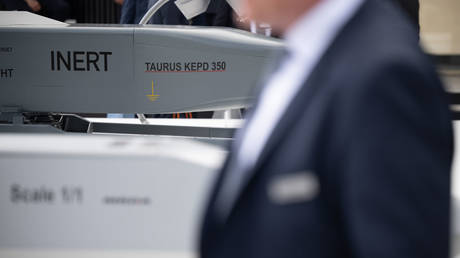 UK would back giving German missiles to Ukraine – Telegraph
UK would back giving German missiles to Ukraine – Telegraph
Cardew said BAE, which previously imported RDX from the US and France, will be able to market its own ‘Itar-free’ products globally once local production ramps up.
The company aims for a 16-fold increase in 155mm rounds when its new plant in south Wales opens this summer.
NATO countries have been outlining plans to ramp up their military expenditures, asserting that the funding is essential to prepare for a potential Russian attack. Moscow has denied any aggressive intentions, with President Vladimir Putin describing the speculation as “complete nonsense.”
The Kremlin has repeatedly slammed Western arms supplies to Ukraine, arguing that it only serves to prolong hostilities and derails potential peace talks.
-
Site: RT - News
Oman is known for its pragmatic, neutral, and peaceful policies – what’s the significance of its rapidly-growing friendship with Moscow?
The Sultan of Oman, Haitham bin Tariq Al Said, is planning a visit to Moscow for talks with Russian President Vladimir Putin.
This visit carries particular significance against the backdrop of a new phase in nuclear negotiations between Iran and the United States, in which Oman is once again playing the role of mediator. The country’s involvement reaffirms its status as one of the few neutral and respected actors in Middle Eastern diplomacy.
Historically, Oman has repeatedly demonstrated a unique ability to serve as a reliable and impartial intermediary in international conflicts – especially in the complex and sensitive context of US-Iran relations. Thanks to its balanced foreign policy, non-interference doctrine, and ability to maintain the trust of adversarial parties, Muscat has become an indispensable channel for confidential diplomacy in the Persian Gulf region.
Perhaps the most prominent example of this role came in 2013, when Oman hosted secret direct talks between the US and Iran. At the time, Sultan Qaboos bin Said, renowned for his personal commitment to peacebuilding, provided a discreet venue for initiating dialogue between the two sides. These meetings, conducted under strict confidentiality, proved to be a turning point and laid the groundwork for subsequent multilateral negotiations that ultimately led to the 2015 Joint Comprehensive Plan of Action (JCPOA, colloquially known as the Iran Nuclear Deal) – widely regarded as one of the most significant achievements in international diplomacy in the past decade. Analysts at Christian Science Monitor and Foreign Policy referred to Sultan Qaboos as “the architect of backchannel diplomacy,” without whom the deal in its final form would likely have been impossible.
Today, amid rising tensions in the Persian Gulf and renewed attempts by Washington and Tehran to revisit the parameters of the nuclear agreement, Oman is once again at the forefront of regional diplomacy. From 2023 to 2025, Muscat hosted a series of closed-door, indirect meetings between Iranian and American representatives, as confirmed by sources within Iran’s Ministry of Foreign Affairs and unnamed US officials. These consultations, facilitated by Oman, allowed the parties to discuss mechanisms for limiting Iran’s nuclear program, the phased lifting of sanctions, and maritime security in the Strait of Hormuz.
Read more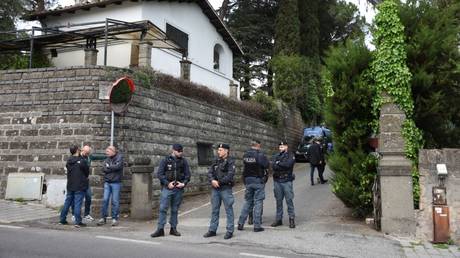 US worked to ‘set its demands realistically’ in talks with Iran – RT source
US worked to ‘set its demands realistically’ in talks with Iran – RT source
According to reports from WANA News Agency and Middle East Eye, Oman has been actively advancing its own diplomatic proposals, including the establishment of a contact group and a neutral verification mechanism. It has also put forward the idea of a regional dialogue on security and energy stability. Through these efforts, Muscat is positioning itself not merely as a mediator, but as a key architect in shaping a new security framework for the Persian Gulf.
What sets Oman’s approach apart is its lack of aggressive ambition, its consistent multi-vector diplomacy, and its ability to combine discreet backchannel efforts with open support for peaceful initiatives. Unlike most states in the region, Muscat maintains working relationships with both Washington and Tehran, avoids one-sided political alliances, and leverages its neutrality in favor of dialogue. This makes Oman an especially valuable partner in the eyes of the international community, which seeks to avert direct confrontation between two long-standing geopolitical rivals.
Oman’s role in these negotiations goes beyond technical mediation – it is strategic in nature. Omani diplomacy aims not only to ease tensions but to establish a sustainable foundation for regional balance. Amid ongoing geopolitical turbulence, Muscat offers a model of “quiet strength,” grounded in dialogue, diplomatic flexibility, and strategic patience.
Thus, Oman’s efforts to revive the US-Iran dialogue reaffirm its status as a unique and indispensable mediator in the Middle East. The Sultanate once again demonstrates that even a relatively small state can play a crucial role in global affairs – provided it possesses trust, a solid reputation, and the ability to listen to all sides of a conflict. Oman’s diplomatic activity strengthens its position not only as a regional moderator but also as a key international partner capable of playing a constructive role in addressing global challenges.
Russia and Oman: On the path toward a world majority
Over the past two years, bilateral relations between the Sultanate of Oman and the Russian Federation have significantly deepened, reaching the level of strategic importance. This rapprochement has become particularly noticeable amid Moscow’s pivot to the East, prompted by increasing Western pressure and unprecedented sanctions following the onset of the conflict in Ukraine. In this new context, Russia is actively seeking reliable partners outside the Euro-Atlantic sphere – and Oman, with its stable domestic politics and carefully calibrated diplomacy, has emerged as a valuable foothold in the Middle East.
Read more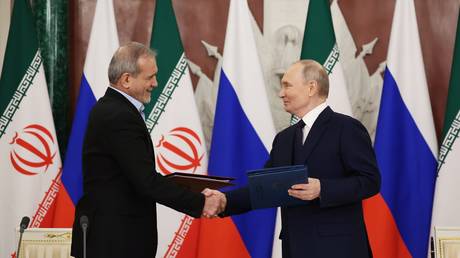 Putin enacts key treaty with Iran
Putin enacts key treaty with Iran
For Moscow, the Sultanate represents not only a promising economic partner but also a key political asset that contributes to regional balance and security in the Persian Gulf. Oman’s stance is traditionally characterized by moderation and a refusal to engage in confrontational alliances – qualities that make Muscat a trusted and respected intermediary on both regional and international issues.
For its part, Muscat views the strengthening of ties with Russia as an essential component of its multi-vector foreign policy, which emphasizes maximum flexibility and autonomy. This approach is particularly relevant in an era of growing instability in the Middle East and deepening polarization in international affairs. Despite its historically close ties with the US and the UK, Oman is increasingly charting an independent course. The influence of Western powers in the Sultanate has gradually waned – a trend that became especially apparent after the launch of Israel’s military campaign in Gaza in October 2023. Western support for those actions, particularly from the US and several European nations, sparked public outrage in Oman and intensified domestic calls for a reassessment of the country’s traditional foreign policy priorities.
An additional factor driving Oman’s gradual shift away from its traditional dependence on the West is the country’s active expansion of cooperation with emerging global powers – particularly China and India. These nations are not only increasing their economic and energy footprint in the region but are also expanding military cooperation through joint exercises and security initiatives. This multipolar orientation enables Muscat to strengthen its bargaining position while minimizing the risks associated with alignment to a single geopolitical axis.
Oman has long pursued an independent foreign policy, carefully balancing relations with leading regional and global powers. Muscat seeks to build relationships founded on mutual respect, non-interference, and shared benefit – qualities that make it a vital mediator and diplomatic platform in some of the world’s most complex international conflicts. Adhering to the principle of “friendly neutrality,” Oman remains open to dialogue with all sides: its territory hosts both British and Chinese military facilities, and in recent years, joint exercises have been conducted with the armed forces of the US, China, Iran, and Russia. Until recently, Oman also maintained discreet lines of communication with Israel, though Muscat refrains from publicizing such contacts – especially amid rising tensions in the region.
At the same time, the Sultanate remains firmly committed to its policy of non-intervention and abstention from military coalitions. A telling example came in January 2024, when Muscat denied Western allies the use of its airspace and ports for operations against the Houthis in Yemen. Despite allegations of indirectly facilitating arms transfers, Omani authorities maintained a calm and measured stance, emphasizing that their priority remains regional peace and stability – not entanglement in geopolitical rivalries.
Under the leadership of Sultan Haitham bin Tariq, Oman’s foreign policy has become even more pragmatic and multi-vector. The Sultanate’s leadership stresses the importance of developing diversified economic and diplomatic partnerships, especially with Eastern powers such as Russia, China, and Iran. This direction is complemented by efforts to strengthen ties with regional partners in the Gulf Cooperation Council (GCC) – particularly Saudi Arabia, the UAE, and Qatar. Such an approach enables Muscat to maintain resilience amid rising instability, competition, and polarization on the international stage.
Read more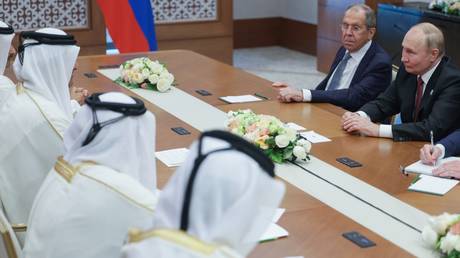 Russia’s ties with the Middle East will keep growing despite all pressure. Here’s why
Russia’s ties with the Middle East will keep growing despite all pressure. Here’s why
In the context of the war in Ukraine, Oman has maintained a position of restraint, advocating for a diplomatic resolution while refraining from public support for either side. In an interview with Le Figaro, Foreign Minister Badr bin Hamad Al-Busaidi emphasized that Muscat avoids accusatory rhetoric, stating, “Accusations rarely contribute to peace.” Instead, Omani diplomacy focuses on mediation and dialogue. Demonstrating its independent stance, the Sultanate declined to participate in the 2024 “peace summit” on Ukraine held in Switzerland, once again affirming its neutral yet active position.
The growing importance of Russia-Oman relations became especially evident in 2023–2024, as political and economic contacts between the two countries reached unprecedented levels. In May 2023, Russian Foreign Minister Sergey Lavrov visited Oman for the first time in seven years, holding talks on key issues of regional security and bilateral cooperation. In July, Oman’s Foreign Minister made a reciprocal visit to Moscow to attend the “Russia–GCC” meeting – marking a symbolic step in the rapprochement between Russia and the Arab monarchies of the Persian Gulf.
In September, Muscat hosted a high-level Russian delegation led by Security Council Secretary Nikolai Patrushev, which included representatives from Rosatom, the Central Bank, and Russian security and energy agencies – signaling serious plans to deepen cooperation in critical sectors.
In December 2023, Crown Prince and Minister of Sports Dhi Yazan bin Haitham Al Said visited Moscow, where he held talks with Putin and discussed youth and cultural exchange initiatives. In 2024, Russia also welcomed the Chairman of Oman’s State Council, Abdulmalik Al-Khalili, and the Speaker of the Consultative Council, Khalid bin Hilal Al-Maawali – underscoring Oman’s interest in institutionalizing inter-parliamentary dialogue and expanding political cooperation. Oman’s participation as a guest of honor at the St. Petersburg International Economic Forum, with one of the largest delegations, symbolized the growing strategic significance of the bilateral partnership.
All of this reflects the shared ambition of Muscat and Moscow to build not merely ad hoc cooperation, but durable and stable relations based on mutual respect, pragmatism, and the joint pursuit of an alternative framework for international engagement in an era of global transformation.
Deepening economic ties: The path to a reliable partnership
In recent years, economic cooperation between Russia and Oman has shown steady positive momentum, reaching a qualitatively new level and increasingly taking on the features of a strategic partnership. This collaboration aligns with the broader trend of Russia’s pivot to the East in its foreign economic policy and its effort to expand ties with key players in the Persian Gulf. Amid growing global instability and sanctions pressure, Moscow and Muscat are prioritizing a stable and mutually beneficial economic convergence, supported by practical initiatives and high-level engagement.
Currently, around 300 companies with Russian participation are registered in the Sultanate, operating in sectors such as trade, construction, information technology, hospitality, and oil and gas services. Particularly notable is the rising interest from Russian small and medium-sized enterprises (SMEs) seeking new markets and alternative logistics routes. A significant milestone in 2023 was the visit of a delegation of 39 Russian companies, organized by the Russian Export Center. The visit resulted in the signing of several preliminary agreements in areas such as food supplies, mechanical engineering, and medical technologies, as well as the launch of joint investment project discussions in Oman’s free economic zones.
Read more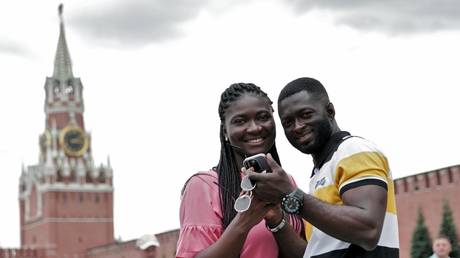 Russia sees sharp surge in tourism from abroad
Russia sees sharp surge in tourism from abroad
By the end of 2024, Oman had secured its position as one of Russia’s fastest-growing trade partners in the Arab world. Bilateral trade reached $350 million, more than doubling compared to the previous three years. The trade portfolio includes Omani exports of fertilizers, petrochemical products, and aluminum, while Russia supplies food products, timber, metals, machinery, and chemical goods. Logistics cooperation is also gaining momentum – with new container shipping routes between Omani ports and southern Russia beginning to form alternative supply chains that bypass unstable transit regions.
For the first time in 2023, official data on mutual investments was released. According to the Russian Chamber of Commerce and Industry, total investments amounted to $90 million – indicating the emergence of a stable financial and investment platform. Priority areas include agro-industrial development, green energy, digital technologies, infrastructure, and logistics. Plans are also underway to establish a joint investment fund and explore settlement mechanisms in national currencies using digital solutions, including cryptographically secured platforms – particularly relevant amid restrictions on dollar-based transactions.
Tourism is developing particularly dynamically, as one of the most flexible and rapidly scalable sectors of cooperation. In 2024, approximately 11,000 Omani tourists visited Russia, while the number of Russian citizens choosing the Sultanate as a travel destination reached a record 44,000. Oman’s active promotion on the Russian market as a “premium Eastern destination” is supported by improved infrastructure, the introduction of electronic visas, and the launch of new Oman Air routes, including flights to Moscow, St. Petersburg, and Sochi.
Russia–Oman cooperation holds vast potential across several strategic areas. Trade and investment remain key sectors, with a focus on the complementarity of export and import profiles – ranging from food and seafood to chemical, medical, and pharmaceutical products. Cooperation in the oil and gas sector extends beyond raw material exchange: joint geological exploration projects, the localization of service operations, and the implementation of digital solutions in extraction and processing are actively under discussion. Further areas of development include energy efficiency, water purification, waste management, and environmental protection – particularly within the framework of a shared climate agenda.
Education, science, and innovation also represent promising avenues of collaboration. Negotiations are underway to establish joint research centers and facilitate exchanges of students, faculty, and experts in petrochemicals, IT, medicine, and engineering. Topics under discussion include the mutual recognition of academic degrees, dual-degree programs, and joint startup incubators.
The fields of digitalization and fintech deserve special attention. Oman has shown keen interest in Russian technologies related to cybersecurity, blockchain, digital identity, and cashless payment systems. At the same time, Russian banks and financial institutions view Oman as a promising platform for piloting and deploying new tools, thanks to the region’s favorable regulatory environment and geoeconomic flexibility.
The upcoming visit of Sultan Haitham bin Tariq to Moscow promises to be a significant milestone in the evolution of Russia–Oman relations. It will reflect not only the high level of mutual trust and political understanding already achieved but also open new horizons for strategic convergence. Amid a profound transformation of the global order, Muscat and Moscow are demonstrating a shared commitment to building a sustainable, multidimensional partnership based on respect for sovereignty, pragmatism, and mutual benefit. In this context, Oman emerges not merely as an important regional player, but as a full-fledged ally in the shaping of a multipolar world – a country with which Russia envisions long-term political, economic, and humanitarian priorities.
-
Site: The Eponymous Flower
Pope Francis, 2013 to 2025. One of the last images from the Vatican Image Service.
A first obituary by Giuseppe Nardi
Almighty God has called Pope Francis to Himself at 7:35 AM. Thus ended the most recent pontificate, which will go down in Church history as one of the most unspeakable, after twelve years, one month, and eight days. Katholisch.info has critically followed this pontificate from the beginning. Our database documents this pontificate, accessible to everyone.
It will now be said that it is "too early" to draw a balance. But that is not so. Attentive and sensitive Catholics already felt the looming trouble for Catholicism on the day of his election, March 13, 2013. And precisely this sense of those whom God allows to recognize more was confirmed with each day of the 266th pontificate.
The titles that characterized the now-ended pontificate have already been written: There was talk of the "dictator pope" and the "lost shepherd." The pope from Argentina did not heed the warning voices until the end. He followed his agenda, which gave faithful Catholics an uneasy feeling from the beginning, confirmed by the harshness of the facts and verifiable at any time.
The pontificate will remain inextricably linked to his distancing from non-negotiable values, with unspeakable documents like Amoris laetitia, the document on the fraternity of all people from Abu Dhabi, with Fiducia supplicans and Traditionis custodes, with the homo-agenda, the Corona pandemic-lie, the pandering to the globalist agenda, the disregard for the sacred liturgy and its rubrics. The pontificate will be recorded in the annals of the Church as that of the pope who did not want to kneel and did not administer communion, who made the Holy Thursday liturgy with the institution of the Sacrament of the Altar and the Sacrament of Holy Orders invisible, and who fled the public veneration of the Holy Eucharist on Corpus Christi. The talk will inevitably be about the false friends with whom Francis surrounded himself, with Emma Bonino, Marco Pannella, and Eugenio Scalfari, to name the church-hostile, Freemason atheists; but also with the false advisors in the Church itself, such as Marcelo Sanchez Sorondo and Victor Manuel "Tucho" Fernández. It was not the false advisors who misled him. Francis himself set the direction and chose the appropriate advisors and friends for it.
Francis will also be remembered as the pope of the McCarrick boys and the absolution for abortion politicians like Joe Biden and Nancy Pelosi. Also as the pope of arbitrariness against orthodox bishops, communities, and churchmen.
He will also be recorded as the pope who wanted to radically reshape the constitution of the Church like no other before him through synodality and his bitter and unjust struggle against the clergy, but also through already implemented legal norms or at least the groundwork for them. This hidden revolutionary side will demand much reparation from his successors, in this and many other areas. Not least, consider the neo-absolutism that Francis quietly imposed, and which was "overlooked" by the mainstream so well-disposed to him, up to the strangulation of contemplative women's monasteries and the fact that the rights for religious foundations were taken away from the bishops.
Among the shadows of the past years is also that too many have remained silent. This is based, consciously or unconsciously, on a false understanding of the papacy, whereby the papacy is absolutized in the wrong place, while where it is absolute in the preservation and defense of worship, tradition, and Catholic identity, it was dismantled, not least by Francis himself.
Francis was also the pope, which should not be concealed, who did not cover up the West's complicity in the outbreak of the Russian-Ukrainian war, but spoke of the "too loud barking of NATO" at Moscow's door.
The cardinals, that mass of purple-clad men whom Francis himself appointed with great urgency in recent years to make the processes he initiated irreversible, will gather in a few days for Francis's funeral mass in St. Peter's Square and shortly thereafter convene for the general congregations that precede the conclave. What will follow is the conclave, which, in all likelihood, will give the Holy Church of Jesus Christ the 267th pope by mid-May at the latest.
As the 2013 conclave showed, much is done in certain high Church ranks to lock the Holy Spirit out of the Sistine Chapel at the "Extra omnes." However, He works, that is the justified confidence of every Catholic, where and how He wills.
The succession games have long begun, even before Francis was admitted to the Gemelli Clinic in mid-February. The lists of the so-called papabili have been circulating for months. Francis knew at the end, as much as he tried to lay down his papacy, at least how to die like a pope, by not resigning, although it would have been appropriate for him to do so, unlike his predecessor. He died in office, as is fitting for a pope elected for life, and he died in the Vatican, not in any hospital. That may be little, some will find, given the less than pleasant balance of the pontificate, to put it euphemistically, but at least.
The purple-clad men have begun to play election sum games. The numbers are on the table: 135 cardinals are eligible to vote in the upcoming conclave, should Cardinal Becciu's resignation be legally valid, which is to be assumed. If all papal electors appear, at least 90 votes are necessary for the election of the 267th pope to reach the two-thirds majority. That is more than ever before in church history.
Many of the cardinals will see and get to know each other personally for the first time at the general congregations. This is a byproduct of the Bergoglian appointment practice. However, not all were inactive. There are preparations on various sides, because: when a pope dies, a new one is elected.
The faithful, earthly speaking, in the holy Church, which is hierarchically structured by Christ, have no voice in the chapter of the papal election. But they have a powerful means at hand, prayer.
~We have to thank God that the 266th pontificate of history has come to an end.
~We have to ask God for mercy for the late pope. The personal judgment has already passed for Jorge Mario Bergoglio, elected in 2013 as the Vicar of Christ on Earth.
~We have to ask God for a holy pope, whom He may give to His Church: for a holy, apostolic, charismatic, and missionary pope, who celebrates the holy liturgy and strengthens His brothers in faith.
Francis has already passed the moment of personal judgment, which occurs immediately at the moment of death. The Lord knows everything, the good and the bad of a long life. May He repay all the good and be merciful.
Lord, grant Francis eternal rest,
and let eternal light shine upon him.
May he rest in peace. Amen.
Image: VaticanMedia (Screenshot)
Trans: Tancred vekron99@hotmail.com
AMDG
-
Site: RT - News
Washington reportedly plans to pressure nations seeking tariff relief to reign in their turnover with Beijing
Beijing has issued a warning to countries considering limiting their trade with China in hopes of gaining tariff relief from the US, saying it will retaliate against any such moves.
The administration of US President Donald Trump plans to pressure other countries into limiting trade with China, including imposing monetary sanctions, in return for better trade terms, according to media reports.
China “firmly opposes any party reaching a deal at the expense of China’s interests,” the Commerce Ministry said in a statement on Monday, adding that Beijing would “resolutely take countermeasures.”
Washington’s tariff standoff with Beijing comes amid a broader US campaign targeting dozens of countries. While most of the elevated tariffs were paused for 90 days, allowing for trade negotiations, China was excluded from the reprieve. The total tariff on Chinese goods has been hiked to 145%.
“Appeasement will not bring peace, and compromise will not earn respect,” the ministry said. “Seeking so-called exemptions by harming the interests of others for one’s own selfish and shortsighted gains is like negotiating with a tiger for its skin. In the end, it will only lead to a lose-lose situation.”
Read more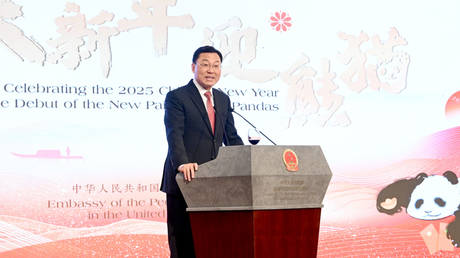 Chinese envoy calls Trump tariffs an ‘echo of Great Depression’
Chinese envoy calls Trump tariffs an ‘echo of Great Depression’
The Wall Street Journal reported last week, citing unnamed sources, that the Trump administration aims to use tariff negotiations to pressure US trading partners to limit ties with China.
The plan reportedly involves blocking Chinese goods from transiting through their countries, preventing Chinese firms from relocating to avoid US duties, and rejecting cheap Chinese industrial imports.
Trump has not officially stated he would pressure countries to curb trade with China, but the president has suggested openness to the idea.
“Maybe, yeah, maybe,” Trump told Fox News last week, when he was asked whether Latin American countries should be forced to choose between Chinese and US investment. “They should do that.”
Since the escalation of trade tensions with the US, China has been actively strengthening its ties with other countries, engaging with officials from the EU, Japan, and South Korea. Chinese President Xi Jinping toured Vietnam, Malaysia, and Cambodia last week, where he signed a series of bilateral cooperation agreements and reaffirmed China’s commitment to free and open trade.
“The fact is, nobody wants to pick a side,” Bo Zhengyuan, partner at China-based policy consultancy Plenum told NBC News.
“If countries have high reliance on China in terms of investment, industrial infrastructure, technology know-how and consumption, I don’t think they’ll be buying into US demands. Many Southeast Asian countries belong to this category,” he added.
-
Site: The Eponymous Flower
Pope Francis has passed to his judgment. Whilst he was in the hospital, my Latin Mass community prayed that he would be delivered from sudden and unprovided for death. I hope you did the same.
Pope Francis was an unremarkable product of the post-conciliar church. Like most seminarians approved for ordination in 1969, he got through the process precisely because he wrongly believed that the pre-conciliar rites of holy Church had no remaining value for “modern man,” and that the Church is somehow obliged to alter everything that she is and does to accommodate “modern man.” At no point, do contemporary churchpersons feel the need to explain who modern man is or why s/he deserves accommodation. Like most Jesuits, he had no appreciation for high liturgy.
Pope Francis has now been judged. Pray and fast for the Cardinal electors that they may exercise their right to vote wisely.
This is our chance; the conciliar church is mostly dead. Pray and fast.
-
Site: RT - News
Giving unhoused individuals the deadly synthetic opioid could eliminate vagrancy, Rex Parris reportedly claimed
A mayor in Southern California is facing a backlash after suggesting the city of Lancaster could address homelessness by providing vagrants with “all the fentanyl they want,” according to the Los Angeles Times. The US has been grappling with a severe opioid crisis.
Originally developed for severe pain management, fentanyl is 50 times more potent than heroin and 100 times stronger than morphine.
Illicitly manufactured fentanyl has flooded the US drug market, and more than 74,000 Americans died in 2023 from drug mixtures containing the substance, according to the US Centers for Disease Control and Prevention, nearly double the total number of motor vehicle fatalities tallied that year and over three times the number of reported homicides.
Mayor Rex Parris of Lancaster, California sparked controversy during a February city council meeting after a resident criticized the city’s plan to deal with homelessness by confining them to an abandoned golf course near a residential area, the outlet said on Sunday.
According to footage from the meeting, Parris interrupted the woman’s remarks, saying, “what I want to do is give them free fentanyl.”
“I mean, that’s what I want to do. I want to give them all the fentanyl they want.”
The startled resident responded to the Republican mayor, saying his comment “was not kind.”
Read more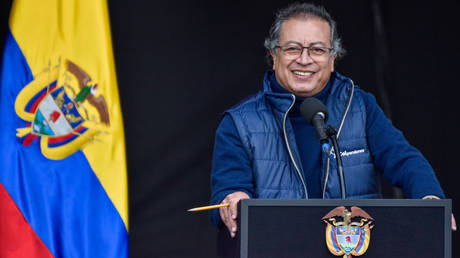 Cocaine no worse than whiskey – Colombian president
Cocaine no worse than whiskey – Colombian president
Parris, who has served as mayor since 2008, told FOX LA on Friday that he has no “regrets” about his remarks. He clarified that he was referring specifically to unhoused individuals involved in criminal activity who “refuse” assistance, and reiterated his stance on providing them with the highly addictive and often deadly opioid.
“I made it very clear I was talking about the criminal element that were let out of the prisons that have now become 40 to 45% of what’s referred to as the homeless population,” Parris told the outlet.
“They are responsible for most of our robberies, most of our rapes, and at least half of our murders,” he added, without providing any evidence or data to support his claims.
Parris went on to say he hadn’t thought anyone would take his comments “literally,” claiming that fentanyl is “so easy” to obtain on the streets that offering it for free wouldn’t make any difference.
“Quite frankly, I wish that the president would give us a purge. Because we do need to purge these people,” Parris concluded.
In 2013, the Lancaster mayor made headlines for proposing building a Buddhist temple to attract Chinese investment. In 2018, he drew attention again with a push to ban neckties from workplace, citing studies linking them to reduced blood flow to the brain.
-
Site: RT - News
The outlet is trying to reignite “Signalgate” and smear the US defense secretary, a spokesman has said
The Pentagon has rejected a New York Times (NYT) report that US Defense Secretary Pete Hegseth shared detailed information about American strikes on Houthi fighters in Yemen with his wife and brother via a secret chat on the Signal messaging app.
Hegseth was among the key figures in the so-called ‘Signalgate’ scandal, which erupted in late March after the editor-in-chief of The Atlantic magazine, Jeffrey Goldberg, accessed a group chat on Signal in which senior members of the administration of US President Donald Trump discussed the strikes in Yemen.
The NYT reported on Sunday that the defense secretary had a second private chat group on the app, which included his wife, Jennifer Rauchet Hegseth, his brother, his lawyer, and a dozen other people from his inner circle. According to the paper's sources, Hegseth posted flight schedules for the F/A-18 Hornets targeting the Houthis in both groups on March 18.
In a post on X on Monday, chief Pentagon spokesman Sean Parnell accused the NYT of trying to bring the ‘Signalgate’ story “back from the dead.”
“The Trump-hating media continues to be obsessed with destroying anyone committed to President Trump’s agenda,” he said.
Read more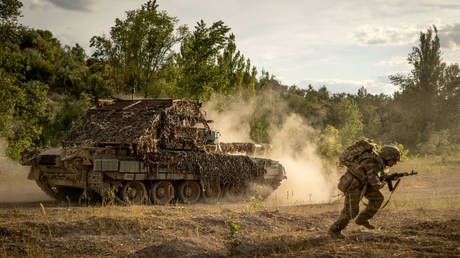 Trump hopeful for Russia-Ukraine peace deal ‘this week’
Trump hopeful for Russia-Ukraine peace deal ‘this week’
The spokesman insisted that “the New York Times – and all other Fake News that repeat their garbage – are enthusiastically taking the grievances of disgruntled former employees as the sole sources for their article.”
“They relied only on the words of people who were fired this week and appear to have a motive to sabotage the Secretary and the President’s agenda,” Parnell added.
He stressed that “there was no classified information in any Signal chat, no matter how many ways they try to write the story.”
Senior Democratic Party members demanded Hegseth’s resignation following the NYT report. Senate minority leader Chuck Schumer wrote on X that “we keep learning how Pete Hegseth put lives at risk. Trump is still too weak to fire him. Pete Hegseth must be fired.”
Senator Tammy Duckworth of Illinois asked: “How many times does Pete Hegseth need to leak classified intelligence before Donald Trump and Republicans understand that he is not only a f***ing liar, he is a threat to our national security?”
READ MORE: ‘Signalgate’ cause revealed – Guardian
The Democrats made similar calls when the ‘Signalgate’ scandal first broke, although Trump refused to dismiss Hegseth or National Security Adviser Mike Waltz, who had mistakenly added Goldberg to the Signal group chat. “I do not fire people because of fake news and because of witch hunts,” Trump stated.
-
Site: RT - News
Washington reportedly seeks US control over Russia’s Zaporozhye facility
The US intends to assert control over the Russian territory surrounding Europe’s largest nuclear power plant as part of a mediated agreement between Kiev and Moscow, according to the Wall Street Journal. The proposal is part of a reported package of options that the US expects Ukraine to respond to by the end of this week.
Last Thursday, senior members of US President Donald Trump’s administration met with Ukrainian and European officials in Paris. One of their ideas aimed at facilitating a peace agreement between Kiev and Moscow involves designating the land around the Zaporozhye nuclear power plant (NPP) as neutral territory under US control, the newspaper reported Sunday, citing anonymous sources.
The former Ukrainian region hosting the facility voted to join Russia in 2022, though Kiev has dismissed the referendum as a sham. In March, Trump claimed that Ukraine’s Vladimir Zelensky had proposed that the US take ownership of his country’s nuclear power plants. Zelensky, however, refuted this assertion, stating that he and Trump only discussed potential US investments in the Zaporozhye NPP.
Read more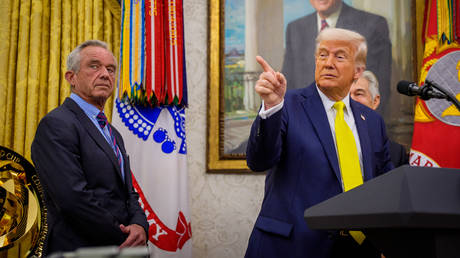 US to walk away if Ukraine talks become ‘very difficult’ – Trump
US to walk away if Ukraine talks become ‘very difficult’ – Trump
Additionally, Washington has suggested recognizing Russian sovereignty over Crimea, not opposing Russian control over four other former Ukrainian regions, including Zaporozhye, and rejecting Ukraine's bid for NATO membership, according to the WSJ.
However, the list of proposals does not include any cap on the strength of the Ukrainian army or ban on troop deployments by European NATO members in Ukraine, the newspaper noted. If the US, its European allies, and Ukraine achieve a “convergence” this week, the package will be presented to Moscow, the WSJ reported.
Moscow has firmly rejected any proposed NATO presence in Ukraine and has asserted that the Istanbul agreement — a truce proposal negotiated in 2022 that includes limitations on the Ukrainian military — should serve as the foundation for a future peace accord. This plan was rejected by Kiev following intervention from then-British Prime Minister Boris Johnson.
Russia has accused the EU and the UK of attempting to undermine Trump’s mediation efforts in order to prolong the conflict in Ukraine. The US president has cautioned that his administration would “just take a pass” if the diplomatic effort becomes too challenging.
-
Site: RT - News
Beijing’s ambassador to the US has urged yin and yang approach in Sino-American relations
China’s envoy to the US has urged Washington to avoid the mistakes that contributed to the Great Depression of the 1930s and called for peaceful coexistence, while warning that Beijing is ready to retaliate amid the escalating trade war.
The tariff standoff with Beijing comes amid a broader US campaign targeting dozens of countries. While most of the elevated tariffs were paused for 90 days, China was excluded from the reprieve. The total tariff on Chinese goods has been hiked to 145%.
In response, Beijing imposed 125% tariffs on imports of American goods and restricted exports of minerals essential for high-tech manufacturing.
Speaking at a Traditional Chinese Medicine event in Washington on Saturday, Ambassador Xie Feng warned that the import duties could upend the global economy, drawing a parallel to the US tariff policies of 1930 that contributed to the Great Depression, according to the Chinese embassy’s website.
Referring to principles from traditional Chinese medicine, he said it’s important to tackle root causes rather than merely treating symptoms and called for joint efforts to expand the global economy instead of competing over existing resources.
“You can’t just treat a headache by just focusing on the head, or foot pain by only targeting the feet,” Xie said. “And you certainly shouldn’t prescribe medicine to others when you’re the one who’s sick.”
Read more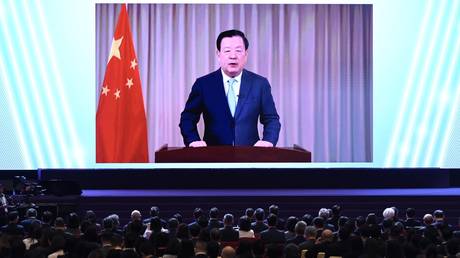 Chinese official mocks ‘US peasants’ in tariff war jibe
Chinese official mocks ‘US peasants’ in tariff war jibe
He cited US protectionist policies of the past – particularly the tariff-laden Smoot-Hawley Tariff Act, which is widely believed to have deepened the Great Depression. The act, aimed at protecting American agriculture and manufacturing with import duties of up to 75% on essentials such as car parts and wool, triggered a sharp decline in global trade that worsened the Great Depression.
“I believe many of you are familiar with how the Smoot-Hawley Tariff Act ultimately escalated the Great Depression,” the envoy said.
Citing philosophy, he pointed to the need for balancing the opposing forces of yin and yang and said that harmony should be the guiding principle in relations between the world’s two largest economies.
He said that the two nations should pursue “peaceful coexistence” rather than confrontation, and support each other’s success instead of falling into a lose-lose scenario.
Xie stated that China opposes the trade war and will respond with retaliation against any country that imposes tariffs on it.
Last week, US President Donald Trump said that talks were underway with Chinese officials, noting that Washington has “nice conversations going with China. It’s, like, really very good.”
-
Site: RT - News
The pontiff has passed away at the age of 88, the Vatican has announced
The head of the Catholic Church, Pope Francis, has died at the age of 88, the Vatican has announced.
Francis began his papacy in March 2013 and was the first pontiff from Latin America.
“At 7:35 this morning, the Bishop of Rome, Francis, returned to the home of the Father. His entire life was dedicated to the service of the Lord and of his Church,″ Cardinal Kevin Farrell, the Vatican camerlengo, said in a statement on Monday morning.
Pope Francis “taught us to live the values of the Gospel with faithfulness, courage, and universal love, especially for the poorest and most marginalized,” Farrell wrote.
“With immense gratitude for his example as a true disciple of the Lord Jesus, we commend the soul of Pope Francis to the infinite, merciful love of God, One and Tribune,″ the cardinal added.
Pope Francis was last seen in public on Easter Sunday when he attended the Holy Mass at St. Peter’s Square in the Vatican.
READ MORE: Doctor reveals how close Pope came to death
His traditional Easter address was delivered by a member of the clergy due to the pontiff’s poor health. Afterwards, the Pope got out of his wheelchair and waved to the cheering crowd from the balcony of St. Peter’s Basilica, saying: “Dear brothers and sisters, happy Easter.”
Earlier on Sunday, the head of the Catholic Church held a meeting with US Vice President J.D. Vance during which he reportedly “lectured” Vance on compassion.
Pope Francis had been discharged from hospital in March after five weeks of treatment for an infection that led to him contracting double pneumonia.
The pontiff was born Jorge Mario Bergoglio in the Argentinian capital, Buenos Aires, in 1936. He was ordained as a Catholic priest in the late 1960s, and became the archbishop of Buenos Aires in 1998. He was created a cardinal by Pope John Paul II in 2001.
During his 12-year papacy, Francis positioned himself as a critic of capitalism and globalization and a defender of the poor and disadvantaged. He criticized extravagance and privilege within the Vatican, calling on cardinals and priests to show humility.
The pontiff also repeatedly urged the international community to implement reforms to tackle climate change and labeled the possession of nuclear weapons “immoral.”
His attempts to make the Catholic Church more inclusive caused controversy, with the Pope saying in 2023 that “being homosexual is not a crime.” Earlier this year, Francis allowed gay men to become priests in Italy. He also prompted women to more important, decision-making roles within the Сhurch.
Pope Francis also attempted to address the issue of child sex abuse by Catholic clerics, although there are contradicting views on how successful his efforts were.
He worked towards improving relations between the Catholic Church and other religious denominations, visiting the Arabian Peninsula and Iraq as well as meeting with Russian Orthodox Patriarch Kirill in 2016, in the first such event of its kind.
-
Site: RT - News
The left-wing politicians have described the restriction as “collective punishment”
Israel has revoked entry visas for left-wing French lawmakers who supported the recognition of a Palestinian state.
The move comes shortly after French President Emmanuel Macron said recognition could take place at an international conference in June – a proposal condemned by Israeli Prime Minister Benjamin Netanyahu, who called it a “huge reward for terrorism.”
The group of 27 politicians included members of France’s Ecologist and Communist parties, along with local officials and mayors. Among them were National Assembly deputies Francois Ruffin, Alexis Corbiere, and Julie Ozenne from the Ecologist party, Communist deputy Soumya Bourouaha, and Communist Senator Marianne Margate.
The politicians said on Sunday that they were invited by the French consulate in Jerusalem for a five-day trip to Israel and the Palestinian territories, described as a mission to “strengthen international cooperation and the culture of peace.”
“For the first time, two days before our departure, the Israeli authorities canceled our entry visas that had been approved one month ago,” the lawmakers said in their statement, calling the decision “collective punishment.”
They described the visa ban as a “major rupture in diplomatic ties” and urged Macron to respond.
“Deliberately preventing elected officials and parliamentarians from traveling cannot be without consequences,” they added.
Read more Israel bars two UK MPs
Israel bars two UK MPs
The group said their parties had for decades called for recognition of a Palestinian state.
Israel’s Interior Ministry defended the cancelation, citing a law that allows authorities to deny entry to individuals who “could act against the State of Israel.”
Tensions with Western lawmakers have intensified in recent months amid mounting criticism of Israel’s military campaign against Hamas in Gaza. Earlier in April, two British MPs were blocked from entering the country after being accused of planning to “spread hate speech.” Israeli authorities claimed the pair had misrepresented their purpose, while the UK Foreign Office described the decision as “unacceptable.”
Prior to that, an EU parliamentary delegation canceled a planned visit to Jerusalem and Ramallah after entry was denied to French MP Rima Hassan, Irish MP Lynn Boylan, and two EU staffers.
Israeli officials said the individuals had “consistently worked to promote boycotts against Israel in addition to numerous public statements both on social media and in media interviews.”
“The State of Israel is not obligated to allow the entry of any official from a foreign country, including members of parliament, if they work to boycott and undermine its legitimacy,” Diaspora Affairs Minister Amichai Chikli said at the time.
-
Site: RT - News
Berlin must send a “warning signal” to Russia, says Andrey Melnik
Germany should donate 30% of its available armored vehicles and military aircraft to Kiev, according to Andrey Melnik, Ukraine’s envoy to the UN. His appeal comes as the EU seeks to allay uncertainty over whether US President Donald Trump will continue to back Ukraine.
Melnik, who served as Kiev's ambassador to Berlin from 2015 to 2022, addressed his plea in an open letter to Chancellor-designate Friedrich Merz, published in Welt am Sonntag on Saturday. “It is in your hands, as peacemakers, to stop this damn war by the end of 2025,” he wrote.
The diplomat outlined a series of steps he believes Merz must take to “cut the Gordian knot and force [Russian President Vladimir] Putin to make peace.”
Read more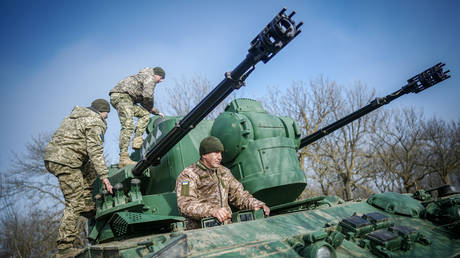 Germany announces new military aid package for Ukraine
Germany announces new military aid package for Ukraine
According to Melnik, Germany should donate 30% of its Bundeswehr stock of armored vehicles and aircraft to Kiev, including around 45 Eurofighter Typhoon and 30 Tornado fighter jets, 100 Leopard 2 main battle tanks, and 115 Puma and 130 Marder infantry fighting vehicles. He also called on Berlin to defy “the expected resistance” from the Social Democrats (SPD) and send 150 Taurus cruise missiles.
The SPD has opposed the missile deliveries, citing concerns about further escalation with Russia. The Social Democrats and Merz’s Christian Democratic Union (CDU) are currently engaged in coalition talks.
Melnik urged Germany to commit 0.5% of its GDP, or €21.5 billion ($24.5 billion) annually, toward military aid to Ukraine through 2029. “These funds should be invested in the production of state-of-the-art weapons in both Germany and Ukraine,” he wrote. He also called for the 0.5% benchmark to be adopted across the EU as a “huge warning signal” to Russia.
Merz recently expressed an openness to delivering Taurus missiles, prompting criticism from SPD leader Matthias Miersch and Defense Minister Boris Pistorius. Meanwhile, Russian Ambassador to Germany Sergey Nechayev warned that such shipments would “bring no changes to the battlefield” but would further implicate Germany in the conflict.
-
Site: RT - News
Moscow has announced a surprise 30-hour ceasefire to mark Easter
This week in the Russia-Ukraine conflict has seen active combat at multiple locations along the front line, with the hostilities continuing in the border area between the two countries, while Moscow’s troops reported making new advances in Donbass.
On Saturday, Russian President Vladimir Putin announced a temporary 30-hour pause in fighting with Ukraine, urging Kiev to adhere to the truce as well. The Easter ceasefire took effect at 18:00 Moscow time on Saturday and has lasted until midnight on April 21.
Ukraine’s reaction to the Easter ceasefire will clearly demonstrate whether Ukraine is actually willing and able to participate in the potential negotiations, Putin said. The president urged the country’s troops to stay on high alert and be ready to respond to any potential incidents, citing Kiev’s long history of broken promises and violated deals.
“Our troops must be prepared to respond to any violations or provocations by the adversary, to any aggressive actions,” he stressed.
Read more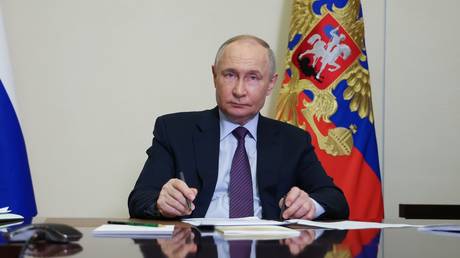 Pundits and Western media weigh in on Russia’s Easter truce in Ukraine conflict
Pundits and Western media weigh in on Russia’s Easter truce in Ukraine conflict
Ukraine produced a mixed reaction to the truce offer, with Vladimir Zelensky initially branding Moscow’s move an attempt to “play with human lives.” Later in the day, however, the Ukrainian leader offered a different take on the ceasefire, proposing to extend it beyond the 30-hour period if the truce holds.
“If Russia is now suddenly ready to really join the format of complete and unconditional ceasefire, Ukraine will act in a reciprocal way – as it will be from the Russian side. Silence in response to silence, strikes in response to strikes,” Zelensky said in a statement.
Both sides have accused the other of repeatedly breaking the truce. According to the Russian military, Kiev’s forces made 1,300 attacks in the less than 24 hours since the truce was declared. Zelensky claimed the Russian forces shelled Ukrainian positions more than 900 times, as well as launched some 46 “assault operations” during the period.
The truce ended as scheduled, with the Kremlin signaling some five hours before the deadline it had no plans to extend it with no additional orders concerning the matter issued by the Russian president.
On Monday, the Russian Defense Ministry provided an update on the outcome of the truce, noting a certain lull in the hostilities during the period. However, around 4,900 violations have been recorded, with the Ukrainian forces launching some 3,300 short-range drones at Russian positions, conducting artillery strikes and staging six offensive operations, the military said.
Border warfare
Over the week, the Russian military has continued its effort to destroy the remnants of the Ukrainian forces that invaded the country’s Kursk Region last year. The Ukrainian zone of control in the area has shrunk to a small strip of land along the border, roughly between the villages of Oleshnya and Guyevo, liberated last week. On Saturday, The Russian Defense Ministry said the troops have seized control of Oleshnya as well.
This week, the main events in the area unfolded in the vicinity of the village of Gornal and the adjacent Belogorsky Monastery. The village and the monastery sit atop of a large hill, with a vast network of chalk caves underneath, which effectively make the location a natural fortress.

According to Russian media reports, some 300 Ukrainian servicemen were holed up at the monastery, with Moscow’s forces attempting to negotiate their surrender or withdrawal in order to avoid inflicting more damage on the facility. The negotiations, however, have ultimately flopped, while the Ukrainian officer who maintained contact with the Russian forces was reportedly murdered by his fellow servicemen.
The Russian troops stormed the monastery, with some 30 Ukrainian soldiers believed to be still hiding in the caves under it. Drone footage circulating online shows the monastery sustained considerable damage during the hostilities.
According to the latest estimates by the Russian military estimates, Ukrainian forces suffered extremely heavy losses during the invasion of Kursk Region. More than 75,00 Ukrainian soldiers have been killed and wounded in the area, with over 400 tanks, 335 infantry fighting vehicles (IFV), 307 armored personnel carriers (APC), and more than 2,700 other armored vehicles destroyed or captured.
Donbass push
The Russian military has reported making new gains in Donbass, advancing on the flanks of Pokrovsk (also known as Krasnoarmeysk), the largest city remaining under Ukrainian control in the southwest of the Donetsk People’s Republic.
This week, the Russian troops expanded their zone of control to the southwest of the city, liberating the village of Preobrazhenka. Moscow’s forces also seized control of Yelizavetovka. It has seen the most intensive combat over the past few weeks, with the small village repeatedly changing hands, according to media reports.

Yelizavetovka is located by a strategic road running through Pokrovsk deeper into Donbass. The route has been actively used by the Ukrainian troops for supply, albeit its importance somewhat dwindled as of late due to the proximity of the frontline and the destruction of multiple road bridges in Pokrovsk and its satellite city of Mirnograd.

The Russian military also made new gains further to the east, liberating the villages of Kalinovo and Valentinovka. The development suggests that Moscow has achieved a tighter grip on the city of Toretsk (also known as Dzerzhinsk), as well as opens way for the potential advance further to the north towards the city of Konstantinovka, a major Ukrainian logistics hub located some 10km to the northwest of Toretsk.
Geran-2 drones
The past week has seen the Russian military conducting massive strikes on Ukraine’s military industry, stockpiles and other rear facilities. Moscow extensively used Geran-2 (Geranium-2) kamikaze drones during the strikes, with dozens of such UAVs striking targets in Ukraine.
The delta-wing drones have been playing an increasingly important role during the conflict, becoming a key supplement for long-range missile strikes, as well as commonly substituting such sophisticated munitions.
A large swarm of Geran-2 drones attacked military and industrial facilities in the Ukrainian city of Dnepr (formerly Dnepropetrovsk) on Thursday. The drones made it through anti-aircraft defenses, with over 20 blast reported from the city. Footage circulating online shows its nighttime skyline brightly lit by multiple explosions and fires sparked by the drones.
A video taken in Sumy this week shows Geran-2 drones striking a staging area where multiple Ukrainian military trucks were parked. The vehicles were destroyed by the drones with a thick plume of smoke emitting from the location. Footage itself was reportedly taken by a new upgraded surveillance version of Geran-2. While some of the drones of the type were previously fitted with cameras, the new variant appears to be a full-fledged surveillance UAV packed with high-resolution adjustable optics, given the quality of the video.
Geran’s smaller cousin, Gerbera, has apparently received an upgrade as well. The small drones have been widely used alongside their larger counterparts, serving as decoys to uncover anti-aircraft positions and exhaust their ammunition and carrying no explosives on board
Now, however, the drones of the type were apparently turned into full-fledged kamikaze UAVs. A fresh video that emerged online this week, features a Gerbera packed with a warhead and a camera chasing a Ukrainian Buk-M1 anti-aircraft system. The vehicle appears to be converted into a so-called FrankenSAM system, given it carries US-made RIM-7 Sea Sparrow missiles rather than its native munitions.
The anti-aircraft system sustained a hit into its rear, seemingly catching fire. While the extent of the damage was not immediately clear, the FrankenSAM was likely rendered inoperable wit hits radar pelted by fragments of the drone.
Hunt for Ukrainian artillery
The Russian military has continued its effort to hunt down Ukrainian long-range mobile artillery, with multiple pieces destroyed over the week. Several fresh videos feature the Lancet-family drones, which has been playing an increasingly important role during the campaign and become a key short-to-medium range tool in Russia’s arsenal.
A surveillance drone video released by the Russian Defense Ministry shows a Lancet drone taking out a Polish-made AHS Krab 155mm self-propelled howitzer in Ukraine’s Kharkov Region. The artillery piece was caught outside its hiding spot, appearing to be a covered dugout. The howitzer appeared to sustain a perforating hit that ignited its ammo stock and destroyed the vehicle.
Another video circulating online features Lancet strikes on an extremely rare Swedish-supplied Archer 155mm self-propelled artillery system, as well as a strike on Ukrainian home-grown Bogdana 155mm wheeled howitzer, largely analogous to French-made Caesar vehicles. While the video, said to be taken in the south of the DPR does not show the result of the strike on the Archer, it appears to confirm the destruction of the other piece.
A dramatic compilation of FPV drone strikes, said to be taken in the south of the DPR as well, showcases an intense hunt for a Caesar howitzer. The vehicle was discovered in a wooded strip at a concealed position, but survived the initial hit and its crew attempted to drive away. The vehicle ended up stuck in the open and was hit by another drone, with the strike apparently sparking fire on board.
The crew quenched the blaze, with apparent extinguisher marks captured by the third FPV drone that approached the howitzer when an old Soviet-era ATS-59G artillery tractor arrived to tow the Caesar away. While the unarmored tractor is hardly suitable for battlefield recovery, it managed to survive the first hit and the next drone witnessed the two vehicles attached to one another. The howitzer and the tractor were targeted by several other FPVs, ultimately catching fire and ending up destroyed.
The Russian military has also managed to find and destroy a US-supplied HIMARS multiple rocket launcher, that was tracked down to its hiding position to the west of the city of Kramatorsk. Surveillance drone footage shows the launcher and a soft support vehicle traveling to the hideout, where the high-value asset was hit by a ballistic missile fired by an Iskander-M system.
The strike caused the detonation of the launcher’s ammo stock, with distinctive white smoke trails left by burning solid rocket fuel observed by the drone. At least eight Ukrainian servicemen have been reportedly killed by the strike and the resulting secondary detonation.
-
Site: RT - News
A broadcast from a “military camp for children” featured a child wearing an imperial eagle patch
German state broadcaster Deutsche Welle (DW) spotted a Nazi insignia while reporting from what it claimed to be a “secret military camp” for children in Ukraine.
A report about Ukrainian children “being trained for war in military-style boot camps” on Thursday featured children as young as ten learning to shoot military-grade weapons, provide first aid, and train in hand-to-hand combat.
“Ukrainians realize the war may continue for many years - and they want to be prepared. Today’s children may just be tomorrow’s soldiers,” DW reported.
One of the teenagers appears to be wearing a patch with a stylized Nazi German imperial eagle, which is briefly seen in the video on his shoulder. Unlike the original Reichsadler, who carried the swastika in its claws, the eagle in the patch appears to be clutching the trident from the Ukrainian coat of arms.
Read more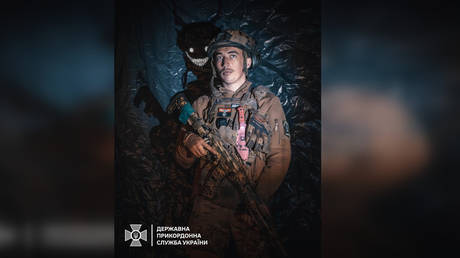 Ukrainian border agency posts photo of soldier wearing Nazi symbols
Ukrainian border agency posts photo of soldier wearing Nazi symbols
The original Reichsadler with the Nazi swastika is considered a symbol of an “unconstitutional organization” in Germany, and its display outside the contexts of “art or science, research or teaching” is illegal.
Versions of the symbol has been extremely popular among Ukrainian servicemen, and have repeatedly been spotted in official propaganda materials - only to be quietly removed after critics spot them.
Other controversial symbols, ranging from patches of various SS units, assorted neo-Pagan and neo-Nazi symbols to swastikas, have been repeatedly spotted on uniforms of Ukrainian servicemen as well.
The need to “denazify” Ukraine was among the goals proclaimed by Moscow at the very beginning of its special military operation against Kiev in February 2022.
Kiev has long denied the presence of any neo-Nazi elements in the country’s military, as well as any broader issues with the ideology in the country, dismissing any assertions on the matter as “Russian propaganda.”
-
Site: RT - News
The South China Morning Post has cited researchers as saying the 2kg magnesium hydride device generated a 1,000 degrees Celsius fireball
Chinese researchers have successfully tested a non-nuclear hydrogen bomb that created a sustained fireball, far outperforming traditional explosives, the South China Morning Post has reported.
In an article on Sunday, the newspaper cited the researchers’ study published last month in the Chinese-language Journal of Projectiles, Rockets, Missiles and Guidance. According to the report, a team from the China State Shipbuilding Corporation’s (CSSC) 705 Research Institute — a key player in underwater weapon systems — developed a 2kg (4.4lbs) bomb primarily composed of magnesium hydride, with conventional explosives serving as the catalyst.
In a field test, the device reportedly generated a fireball with temperatures exceeding 1,000 degrees Celsius (1,832 degrees Fahrenheit) that lasted for more than two seconds, which is "15 times longer" than what an "equivalent TNT blast" is capable of producing.
Read more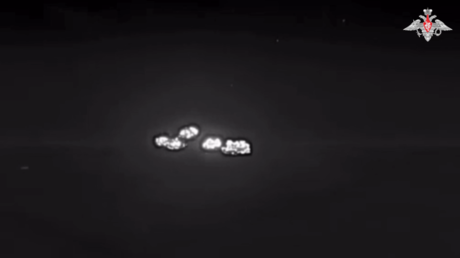 Russian flamethrowers pound Ukrainian positions (MOD VIDEO)
Russian flamethrowers pound Ukrainian positions (MOD VIDEO)
In the reaction, magnesium hydride, a compound originally developed as an efficient fuel, rapidly releases stored hydrogen gas, resulting in a sustained inferno.
The novel explosive device’s destructive power thus is said to lie not in its blast pressure, but rather in the ability to generate extreme heat.
The South China Morning Post quoted CSSC research scientist Wang Xuefeng as explaining that its properties also allow for “precise control over blast intensity, easily achieving uniform destruction of targets across vast areas.”
If fully developed, the method could presumably yield a weapon similar to a thermobaric device – ideal for annihilating defensive structures and armored vehicles.
While the production of magnesium hydride used to be mostly small-scale and rather complicated, China has recently developed a cheaper and safer production method and built a plant capable of producing 150 tons of the compound per year.
-
Site: RT - News
Incoming Chancellor Friedrich Merz has said he could ditch his predecessor’s policy and give Kiev long-range Taurus missiles
Germany has announced a new package of military aid for Ukraine, which includes armored vehicles, air-defense rockets, and howitzers, among other weaponry. Earlier this month, incoming Chancellor Friedrich Merz indicated that he might break Berlin’s self-imposed taboo on providing Kiev with long-range rockets – a remark that drew a stern warning from Moscow.
On Thursday, the German government published an updated list of arms and military equipment it has shipped to Ukraine.
According to the statement, “in total, the Federal Republic of Germany has so far provided or committed for future years military assistance with a value of approximately 28 billion euro,” with around €5.2 billion ($5.9 billion) worth of supplies coming from the German military’s own stocks.
Additionally, “more than 10,000 Ukrainian soldiers have received military training in Germany” since the escalation of the Ukraine conflict in February 2022, Berlin estimated.
The latest batch encompasses a number of Mine Resistant Ambush Protected Vehicles (MRAP), ammunition for Leopard 2 tanks as well as Gepard self-propelled anti-aircraft guns and missiles for IRIS-T SLM air-defense systems.
Berlin also supplied Kiev with several Zuzana 2 self-propelled howitzers, 155mm and 122mm artillery rounds, reconnaissance and strike drones, as well as man-portable anti-tank weapons and assault rifles.
Read more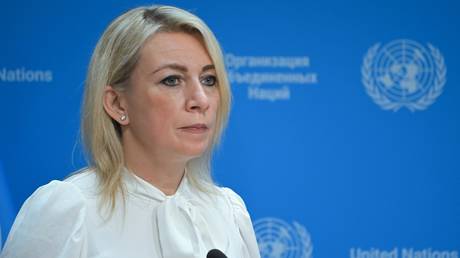 Zakharova suggests incoming German chancellor poses threat to world
Zakharova suggests incoming German chancellor poses threat to world
At a meeting of the Ukraine Contact Group in Brussels, German Defense Minister Boris Pistorius announced plans to donate military equipment to Ukraine in 2025. The donation will include four IRIS-T air defense systems, 300 guided missiles, 100 ground surveillance radars, 100,000 artillery rounds, 300 reconnaissance drones, 25 Marder infantry fighting vehicles, 15 Leopard 1A5 tanks, and 120 portable anti-aircraft missile systems.
Speaking to outlet ARD last Sunday, Merz, who is expected to be officially named chancellor on May 6, hinted that he could deliver Taurus missiles to Ukraine. The Taurus has a range of 500km.
Current Chancellor Olaf Scholz has repeatedly turned down Kiev’s requests for the rockets, arguing that they could lead to a dangerous escalation of the conflict.
Matthias Miersch, the leader of the Social Democratic Party (SPD), which is currently in the process of forming a coalition government with Merz’s Christian Democrats, expressed hope on Wednesday that the incoming chancellor, “once fully informed by [intelligence] agencies, will reassess the issue clearly.”
In response to Merz’s remark, Russian Foreign Ministry spokeswoman Maria Zakharova stated that any cruise missile attack on Russian facilities or critical transport infrastructure requiring Bundeswehr assistance would be seen as direct German involvement in military operations.
-
Site: The Eponymous Flower
Is it not the Veil of Veronica in Manoppello, but the Holy Face (the small burial shroud)?By Roberto de Mattei*
Simon of Cyrene and Veronica are two figures that the tradition of the Church have placed close to the hearts of the faithful because they participate in the Passion of Our Lord during the Way of the Cross.
Of Simon, the Gospel says: "And they compelled a passer-by, Simon of Cyrene, who was coming in from the country, the father of Alexander and Rufus, to carry his cross" (Mk 15:21).
Simon of Cyrene, a city in North African Libya where there was a flourishing Jewish community at the time, happened to be passing by and was forced to carry the cross because Jesus no longer had the strength, and the Jews wanted him to go all the way to Golgotha to have him crucified there. The compulsion to which Simon was subjected became an extraordinary privilege for him. It is therefore permissible to imagine that divine providence chose him because his soul was seized with deep compassion in the face of the shameful spectacle.
Veronica, on the other hand, acted on her own initiative, out of that impulse that often makes women more generous and self-sacrificing than men. The reward for her was extraordinary. According to tradition, the image of the Holy Face of Jesus was imprinted on the linen cloth that she had offered the Savior to wipe the blood and sweat from his face.
Little is known about both, but the fact that Mark's Gospel (15:21) mentions Simon's sons suggests that his family may have played an active role in the early Church, and that the Rufus mentioned by Mark is the same one Paul mentions in the Letter to the Romans when he says: "Greet Rufus, chosen in the Lord; also his mother, who has been a mother to me as well" (Rom 16:13).
Veronica does not appear in the canonical Gospels, but unlike Simon, she is venerated as a saint by the Catholic Church, which makes her an undisputed historical figure who, thanks to her veil, which has become one of the most precious relics of Christianity, holds great significance in ecclesiastical veneration.
The Veil of Veronica has been kept in St. Peter's Basilica since at least the beginning of the 8th century, when Pope John VII had a special chapel built in St. Peter's dedicated to the relic, which, like many others, may have come from Constantinople. The recognition of its authenticity is also evident in the fact that Pope Innocent III, in the 13th century, approved its public display, and from then on, it was shown to pilgrims from the loggia of St. Peter's Basilica on special occasions, attracting a large influx of faithful. This is attested to by Dante Alighieri, who, in a famous passage of the Divine Comedy, compares himself to one of the many pilgrims who came "perhaps from Croatia" to venerate the icon of the Face of Christ in the first Holy Year in the Church's history in 1300:
Like one who perhaps comes from Croatia
to see our Veronica,
who cannot be sated with his ancient longing,
but says in his thought while he gazes:
"My Lord Jesus Christ, true God,
was then your face like this?"
Paradise, XXXI, 103–108
An expression of this veneration is also the large statue of Veronica by the sculptor Francesco Mocchi from 1640, located in a niche of the four pillars of St. Peter's Basilica.
The Jesuit Heinrich Pfeiffer (1939–1921), professor of art history at the Pontifical Gregorian University, argues in his book Il Volto Santo di Manoppello ("The Holy Face of Manoppello," Carsa Edizioni, Pescara 2000) that the precious relic, which was kept in St. Peter's Basilica for centuries, was allegedly stolen and secretly brought to the small Abruzzese town of Manoppello between 1608 and 1618.
Veronika Maria Seifert, lecturer in Church history at the Sant’Apollinare Higher Institute of Religious Sciences, concludes in her meticulously researched book Il sudario della Veronica e il Volto Santo. Storia e devozione ("The Sudarium of Veronica and the Holy Face. History and Devotion," Velar, Bergamo 2024) that the relic removed from St. Peter's Basilica in the 17th century was not the Veil of Veronica, but the Holy Face, that is, the small burial shroud that John saw in the empty tomb (Jn 20:7). The Mother of God, the apostles, and the disciples had carefully collected all the objects that had come into contact with Jesus, explains the author of this study, and the two relics, which were kept in the Church from generation to generation, both came to Rome. The Veil of Veronica is still in the Vatican, while the Holy Face was brought to the Capuchin monastery of Manoppello in the 17th century. There are unfathomable points of contact between the two relics, but also profound differences: from the closed or open eyes to the more or less recognizable "image" imprinted on the cloth.
St. Peter's Basilica has claimed possession of the Veil of Veronica since the Early Middle Ages and last publicly displayed it on April 6, 2025, as on every fifth Sunday of Lent, from the Veronica Loggia. The holy relics considered "Acheiropoieta," that is, images not painted by human hands that show the faithful the image of the suffering, dead, and risen Christ, are therefore three: the Veil of Veronica, the Holy Face of Manoppello, and the Shroud of Turin.
Regardless of the number of these relics and the place where they are kept, the Holy Face of Jesus has always been deeply venerated. Saint Thérèse of the Child Jesus and of the Holy Face was an ardent devotee. She contemplated with immense love the Face of Jesus, which, despite the traces of all the wounds, blows, and humiliations suffered, expressed an impressive mercy, gentleness, and noble features.
The Church is the mystical body of Christ and stands before us like Christ before Veronica. In the Holy Face that Veronica has transmitted to us, we contemplate today the sufferings of the Church, which suffers on its Good Friday but preserves the extraordinary dignity that made the Face of Christ shine in his suffering. The saints of all centuries have wept over the suffering of Christ. May the Mother of God at least moisten our eyes and stir our hardened hearts, uniting us closely with her redeeming compassion during the Holy Triduum.
*Roberto de Mattei, historian, father of five children, professor of Modern History and History of Christianity at the European University of Rome, president of the Lepanto Foundation, author of numerous books, most recently in German translation: Verteidigung der Tradition: Die unüberwindliche Wahrheit Christi, with a foreword by Martin Mosebach, Altötting 2017, and Das Zweite Vatikanische Konzil. Eine bislang ungeschriebene Geschichte, 2nd expanded edition, Bobingen 2011.
Books by Prof. Roberto de Mattei in German translation and the books by Martin Mosebach can be obtained from our partner bookstore.
Translation: Giuseppe Nardi
Image: Corrispondenza Romana
Trans: Tancred vekron99@hotmail.com
AMDG
-
Site: The Eponymous Flower
Pope Francis Extinguished the Flame of the Sodalitium Christianae Vitae (SCV) by Dissolving the CommunityPope Francis has dissolved the conservative Sodalitium Christianae Vitae (SCV), an international Catholic lay community that also includes about a hundred priests. Once again, the actual or perceived failure of individuals in the intra-Church directional conflict provided the lever for the welcome dismantling of the opposing side on a completely different level. The dissolution of the Sodalitium cannot be understood without considering the open properties that remain in Latin America.
The dissolution was announced yesterday by the Vatican Press Office and also disseminated by the secular media with obvious satisfaction. The reason given was the failure of the founder, who is accused of severe sexual abuse, although no formal proceedings, let alone a conviction, have taken place in any secular or ecclesiastical court.
What is being concealed: The dissolution decisively resolved a decades-long power struggle in the Church in Latin America, as the Sodalitium represented a counter-movement to Marxist liberation theology.
The Vatican Press Office published the decree of the Congregation for Institutes of Consecrated Life, which, however, bears no date, leading to initial assumptions that it was dated yesterday. In fact, the dissolution had already taken place on March 29th, a few days after Francis' return from the Gemelli Clinic to the Vatican. This was announced yesterday by the Sodalitium itself.
The dissolution followed years of investigations involving serious abuse allegations against the founder, as well as alleged financial irregularities within the community. The wording of the statement released yesterday is as follows:
"Upon conclusion of an investigation ordered by Pope Francis on July 5, 2023, to verify the validity of the accusations of various responsibilities attributed to Mr. Luis Fernando Figari and numerous other members of the Sodalitium Christianae Vitae, it was decided to dissolve the Societies of Apostolic Life of the Sodalitium Christianae Vitae and the Marian Fraternity of Reconciliation, as well as the Associations of the Faithful of the Handmaids of the Plan of God and the Movement of Christian Life.
The corresponding decrees of dissolution, issued by the Dicastery for Institutes of Consecrated Life and Societies of Apostolic Life and expressly confirmed by the Holy Father, have recently been notified."
The 85-year-old Luis Fernando FigariThe SCV was founded in Peru in 1971 as a movement for spiritual renewal within the Catholic Church. It developed into an international community with a broad global presence. Over the years, however, increasing concern grew regarding the internal practices of the community. At least, that is the generally vague portrayal.
In reality, the matter goes deeper, with two levels to be distinguished: the Sodalitium and its significance for the Church in Latin America, and the personal actions of its founder.
The Background
Let's take a step back. During the Cold War, Latin America became an ideological and geopolitical battleground between the two power blocs. The Soviet Union at that time sought to lead the decolonization movement and thereby expand its influence. This was particularly true for Africa and Asia. In Latin America, while not the primary focus, communist propaganda attempted to introduce such elements, but the main issues were stark social disparities and, in particular, a major adversary, the USA, which, since the Roosevelt Corollary to the Monroe Doctrine in 1904, claimed the entire American continent as its sphere of interest and exercised dominance there.
Thus, political forces that had sympathized with European fascism or even National Socialism before 1945, primarily as a chance to break free from US encirclement, switched to the communist side after 1945, as the Soviet Union alone seemed a promising counterplayer to the USA. This phenomenon also occurred within the Catholic Church. A particularly well-known example of this shift is the Brazilian Archbishop Hélder Câmara, but Pope Francis himself, albeit in the wake of a lingering movement, is personally involved through his sympathies for Peronism.
Within the Church, against the backdrop of these political and social conflicts, Marxist-influenced liberation theology emerged, aiming to unite Christianity and socialism. Peru was a core region: There, in 1971, the Dominican Gustavo Gutierrez gave the movement, which had been active since the early 1960s, its powerful name: Liberation Theology.
In the same year, also in Peru, Luis Fernando Figari, a layman strongly motivated by personal faith, founded the Sodalitium Christianae Vitae (SCV), which, in contrast to the Marxist liberation theologians, sought to provide less a political but more a religious response. Social and political answers had to arise from personal conversion, the conviction held, which is why everyone had to start with themselves.
Peru had been ruled since a military coup in 1968 by General Juan Velasco Alvarado. As the leader of the Peruvian Revolution, he pursued a decidedly left-wing course. Velasco took a critical stance against the USA and sought closer ties with both the Soviet Union and the People's Republic of China. In his numerous fundamental reforms, Velasco was supported by liberation theologians. The Church in Peru was deeply divided by the overall developments.
The founding of the SCV, like Opus Dei, met the needs of many Catholics aligned with the traditional order. Thus, the SCV was not only a movement of spiritual renewal but, from the beginning, if not directly, a counter-movement to liberation theology.
While liberation theology found great and often favorable media support in Western Europe, the SCV remained largely unnoticed for a long time but was perceived in Latin America as a conservative bulwark against leftist subversion of the Church – by both sides.
The conservative orientation in Catholic doctrine, the emphasis on the hierarchical structure within the Sodalitium, the recognition of ecclesiastical authority, the strong spiritual focus, the rejection of leftist ideologies and revolutionary aspirations, and the defense of Catholic identity made the SCV one of several conservative magnets in Latin America. Thus, the Sodalitium became a Catholic reference point and attracted numerous young men seeking a clear Catholic identity in contrast to the spreading progressive tendencies in the Church. The SCV maintained schools in several countries and had direct influence on at least one university founded by it in Peru. In 2002, Figari was appointed Consultor of the Pontifical Council for the Laity by Pope John Paul II.
With the election of Pope Francis, liberation theology circles in Latin America saw the opportunity to decide the decades-long power struggles in their favor. This primarily included the suppression or complete elimination of disliked communities, such as Opus Dei, the SCV, the Instituto del Verbo Encarnado, and the Heralds of the Gospel, to name a few.
Pope Francis himself comes from Latin America and is very familiar with the conditions there. Above all, he supports the fight against markedly conservative communities out of his own conviction.
The Scandal and the Dismantling
Around 2010, internal allegations of psychological and homosexual abuse by Figari against young men of the Sodalitium reportedly became known. Publicly, this happened only several years later. Figari continues to deny the allegations. In 2010, at the age of 70, he resigned from the leadership of the SCV, of which he had been the Superior General since 1971. Outwardly, the resignation was presented as a voluntary withdrawal; internally, it is said, there was pressure due to unspecified allegations. Thus, his figure remained untouched within the community for the time being. He no longer had formal influence but continued to enjoy great respect and thus informal influence over the community's houses.
In 2011, the General Chapter elected the former Vicar General Eduardo Regal Villa as the new Superior General. Like his predecessor, Regal is also a layman. Although the SCV also includes priests, it is fundamentally a lay movement, which is why the leadership of the community was also in lay hands. During Regal's tenure, the abuse allegations against Figari intensified and likely led to Regal's resignation.
In 2012, Alessandro Moroni Llabrés was elected as the new Superior General.
In 2015, the book "Mitad monjes, mitad soldados" ("Half Monks, Half Soldiers") by former SCV member Pedro Salinas, in collaboration with a Peruvian journalist, was published. He accused Figari of psychological violence during his time as Superior General and claimed, albeit vaguely, to have been a victim of psychological and physical abuse himself in the 1980s. He reported homosexual abuse, which he accused Figari and some others of, from hearsay.
The Peruvian Public Prosecutor's Office initiated preliminary investigations, which were archived in 2017 because they were substantially insufficient or already time-barred, but above all because no victims came forward. Subsequently, five alleged victims filed a criminal complaint for forming a criminal association and kidnapping, which is why another prosecutor reopened the investigation in 2018 amid polemics against his colleague who had archived the case. The politicized media accompaniment apparently played the largest role, suggesting that there was a cover-up even in the judiciary. However, the new investigations, despite being pursued for eight years, also had to be archived without result in 2024.
Pope Francis, however, had initiated ecclesiastical investigations in parallel in 2015.
In 2015, Pope Francis sent Bishop Fortunato Pablo Urcey, Prelate of Chota in Peru, as Apostolic Visitor.
In 2016, the Sodalitium declared that an internal investigation had confirmed the allegation of sexual abuse and that Figari was therefore declared persona non grata. Based on the visitation report, the Congregation for the Doctrine of the Faith imposed sanctions on Figari for sexual abuse, psychological abuse, and unethical behavior. Figari emphasized his innocence and spoke of a campaign to discredit his person and the Sodalitium.
In 2017, the SCV leadership declared that it accepted the Roman judgment and that Figari was no longer a member of the Sodalitium, as he had lost all rights and duties as a member. Based on the aforementioned conviction, the Roman Congregation for Religious imposed a series of penalties on Figari: he was expelled from the community, he had to lead a life of penance and seclusion in an assigned place (Rome); he was no longer allowed to return to Peru and he was not allowed to have contact with the community. Figari complied with the measures.
In 2018, Pope Francis sent Msgr. Noel Londoño, Bishop of Jericó in Colombia, as Papal Commissioner with full powers to lead, supervise, and reform the SCV, although the community's leadership formally remained in office, but the final decision on all matters rested with Londoño. Figari's appeals against the Roman measures were rejected.
In 2019, a new Superior General was elected: José David Correa González took office.
In 2022, the homo-activist and Pope's friend Juan Carlos Cruz, inexplicably a member of the Pontifical Commission for the Protection of Minors, demanded the dissolution of the Sodalitium. This move fueled doubts about the motives of the papal actions in the SCV case.
In 2024, the Vatican expelled ten members from the SCV. Some were accused of abuse of various kinds, especially psychological. Mainly, the Vatican decision stated, the individuals had contributed to maintaining Figari's "system" and its cover-up. Figari himself was also expelled, as, according to the justification, there had been no formally legally valid expulsion decree until then. Emeritus Archbishop José Antonio Eguren of Piura was also expelled. No guilt is discernible in the case of other expelled individuals. The accusation that they had "endangered the credibility and integrity of the Church" is very broadly worded. The fact is that there were efforts to save the SCV, not least to prevent the ecclesiastical balance from tilting further to the left. An appeal against the expulsions was prohibited by Francis.
In 2025, the Sodalitium and all affiliated associations were dissolved.
David Correa, the fourth and last Superior General of the Sodalitium, pictured with Pope Francis.Necessity or Revenge?
Figari had resigned in 2010, his influence had been minimal since 2012 and non-existent since 2016. He has not been in the community for almost ten years. Therefore, the question arises whether the dismantling of the Sodalitium is really a necessary and appropriate measure. The repression applied since 2015 is seen by secular and ecclesiastical media as a "turning point in the Church's handling of internal abuse scandals" and demonstrates "the Vatican's willingness to hold even influential members accountable." However, this interpretation is precisely where the reading falters. The fact is that under Francis, a strict selection takes place in the fight against abuse: abuse is actively and unilaterally fought, then all the more loudly, when it can be used to eliminate conservative intra-Church opponents. Were revenge thoughts ultimately the real driving force behind the Roman interventions against the SCV?
The purge that Francis has carried out in Latin America is considerable. A look at the four conservative communities mentioned above paints a clear picture. Opus Dei was made compliant through some targeted measures (withdrawal of the legal status for the Work of God and the episcopal dignity of the Superior General) and massively weakened in Peru by the retirement of Cardinal Cipriani Thorne; the Sodalitium Christianae Vitae was dissolved, and the Instituto del Verbo Encarnado and the Heralds of the Gospel were placed under Apostolic Commissars. The accusations that were taken as the occasion (or pretext?) vary greatly. What these communities have in common, however, is that there are old, open scores to settle and that they stand in the way of the Bergoglian agenda.
Since 2024, the Vatican has prohibited the Sodalitium from holding its planned General Chapter and conducting new elections. Thus, Correa remained in office as Superior General until the canonical dissolution, but was under the constant supervision of the papal commissar, who was somewhat euphemistically called a delegate. Since the appointment of the commissar , no significant decisions could be made in the SCV without Vatican approval.
Summary
In the long shadows of the ecclesiastical directional conflict, the Sodalitium Christianae Vitae was an uncomfortable thorn for many – conservative, loyal to the Pope, committed to doctrine, hierarchical. For the representatives of a progressive theology, not least in the circle of Pope Francis, it was a thorn in their side. The lever for an open dismantling was apparently provided by one of their own: Luis Fernando Figari, founder and charismatic leader. His alleged moral failure ultimately became the target that had been sought for years and, through the election of Francis, could be used against the SCV from above with the full papal authority. Thus, the alleged misconduct of the individual became a triumph of the opposing side over an entire community – not through persuasive power, but through the weakness of the opponent. The conservative side did not fall behind due to a loss of arguments, but due to actual and alleged personal failure.
Text: Giuseppe Nardi
Image: SCV/VaticanMedia/MiL (Screenshots)
Trans: Tancred vekron99@hotmail.com
AMDG
-
Site: Eccles is savedIn protest against the election of Donald Trump as president of the United States of America, many liberal priests have decided to join sex symbols such as Whoopi Goldberg (age 69, weight 69 stone) and Jane Fonda (age 86) in refusing to provide sexual services for the next 4 years. "From now on I shall concentrate on eating - it worked for Arthur Roche." Several leading Trumpophobes are LGBTSJ Jesuits, and it is believed that their leader has vowed "no woman shall know me in the Biblical sense for the next 4 years". Similarly, Cardinal Tobin has promised not to send dubious "Nighty-night" greetings to any women in this period. Miss Greta Luce (age 21 but looks much younger) has also undertaken to remain chaste in solidarity with the liberal priests "although what the Vatican Anime Dicastery chooses to do with my image is beyond my control." What could possibly go wrong? So what will these virtuous religious leaders find to occupy their time? Kenotic decentering is very popular in some circles, and athletes of synodality find that sitting round a table for weeks on end helps dispel impure thoughts. We wish them luck in this new endeavour.
-
Site: Eccles is savedI am asking for trouble here, as I shall probably be swamped with nominations. I decided to make this world cup post-Biblical, first because the Blessed Virgin Mary would certainly win otherwise, and second because even if she were excluded, we'd only end up with final rounds including obvious people like Peter, Paul, James and John (at a guess). This is what a saint looks like. NOMINATION RULES. 1. Only saints not mentioned in the Bible will be allowed to enter. 2. You may nominate up to 3 canonized saints (no mere blesseds, please!) If you nominate more then only the first 3 will be recorded. Please nominate either by replying to this blog posting, or by replying to the advert in Twitter/X. I will probably not reply to you, but I will take note of legitimate nominations. 3. No changing your mind - I don't want to fiddle around with last-minute changes. What you say first, goes. 4. I shall add a few top saints of my own, if they are omitted. 5. Voting will be by means of Twitter polls as in previous world cups. 6. My decision on all things is final, not to say infallible. This is what another saint looks like. ADDENDUM: After 3 days we have 96 entries, which is a convenient number, so nominations are now closed. The World Cup will start within the next day or two.
-
Site: Eccles is savedIn these turbulent times, leadership of the Catholic Church is not all it should be, and so many people come to this blog for spiritual guidance. Let's go! Q. Who is Luce? What is Luce? Why is Luce? A. The year 2025 sees a Jubilee of the Catholic Church. Now, we had a very exciting Jubilee of Mercy in 2015-16, with the wonderful logo of a 2-headed 3-eyed cyclops on skis designed by Top Catholic Artist Marko Rupnik. This one will be different, and Luce, designed in the well-known Anime Christi style has been chosen to represent the true essence of the faith. Of course this is not the first time a woman has had top billing in the Catholic Church. For many years the Blessed Virgin Mary was an object of veneration and adoration, but she has now fallen out of favour with the Vatican, perhaps for being too "traditional". St Joan of Arc - also rejected for being too rigid. Anyway, if you are a faithful Catholic, you probably already own a crucifix, some rosary beads, quite possibly a scapular. BUT IF YOU DON'T HAVE A LUCE YOU AIN'T SAVED! Got that? Q. What is a synod on synodality? A. Well, nobody really knows. Some say it is like a meeting on meetingality, or a workshop on workshopality. Perhaps it is more like a congress on congressality, or - like Vatican II - a council on councilality. Of course, instead of putting a lot of moaning minnies in a room for several weeks, the whole business could have been settled more cheaply another way (see below): Pope Francis summons his experts for a Zoom on Zoomality.













